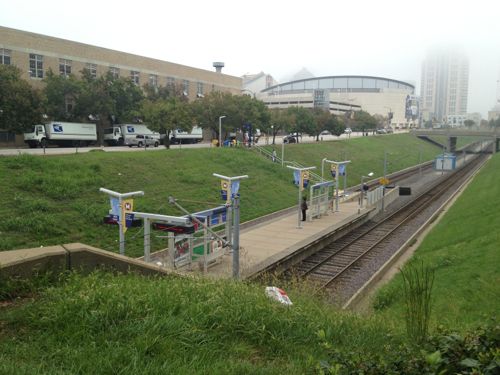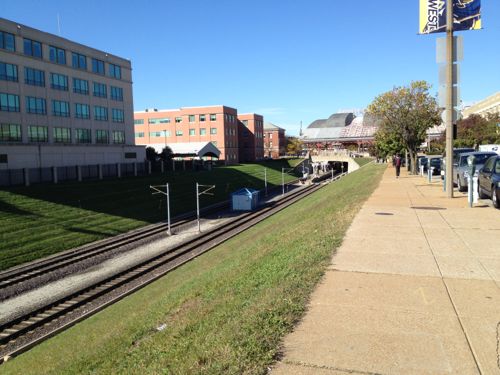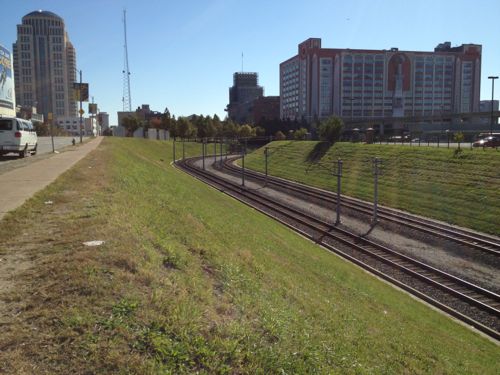Building Over Light Rail
Yesterday I posted about moving the Union Station MetroLink platform into the former baggage tunnel (see The Union Station MetroLink Stop Should Be Moved Under The Train Shed), my reasoning was improved connection to Union Station. Today is the rest of my thought process.


It’s been a white but I’ve written before (link) that I want to see the tracks from 16th to 18th street built over with a new building(s). With the platform moved under the train shed the new building(s) in this two-block stretch wouldn’t have to deal with space for an entrance to the station, making it more straightforward.

Another building could be built over the tracks for a block, before the track curves. This is basically from 16th to where the former 15th Street used to be. A walkway along the east edge could connect Clark Ave to the Gateway Transportation Center (Amtrak & Greyhound).
Back at 16th new buildings would be on each side to help frame the entrance into that area, now largely a jumble of surface parking. The area isn’t very big and has defined edges. Formerly this was an eight block area but the street grid has been dismantled to the point actual blocks are no longer recognizable. It can become more connected so when someone arrives in St. Louis they can easily walk to Union Station or the Drury Inn on 20th facing the train shed.
— Steve Patterson
While I certainly “get” why this would be a good thing from an urban design standpoint, it makes very little sense from an economic standpoint, given the dynamics of the surrounding area. The still-vacant Ball Park Village is several blocks away and at least half of the surrounding private land is dedicated to surface parking or unused rail yards. It would cost more to build over the tracks than it would cost to build at grade, across the street or a block or two away, and you’d still have to coordinate with Metro on multiple issues (air rights, safety, high-voltage wires, maintaining service, etc) that would be non-issues on any other site. Until nearby land becomes much, much more valuable, your vision will remain one of those great ideas that have very little possibility of actually getting built (and why non-urban planners tend to view urban planning visionaries with varying degrees of skepticism).
A final issue is the assumption that most Metro riders (would) actually prefer a station located in a tunnel over one “exposed to the elements”. While it depends greatly on what the weather is actually doing, most of the time I’d rather be exposed to / actually enjoying the “elements” than to be stuck waiting in grey, cold (in winter), poorly lit “subway” station. The ideal platform solution is one that offers both options – good weather protection (for bad days) and fresh air, sunlight and the eyes of non-riders (for good days).
And the city should be advancing good urban design concepts even if people can’t see the economics work at the time. This is about leveraging several existing assets (two MetroLink stations, a future MetroBus center, the Gateway center with Amtrak & Greyhound). Advance the thinking to begin to change perceptions. In 5 years time someone might have a proposal that justifies the expense over the tracks.
This what several million dollars bought in Denver – a lid over one station along with a landscaped plaza. Who paid for it? The government / taxpayers: https://maps.google.com/maps?q=1300+South+Washington+Street,+Denver,+CO&hl=en&ll=39.693335,-104.97896&spn=0.001156,0.001725&sll=38.6531,-90.243462&sspn=0.212346,0.441513&oq=1300+s+washington,+denv&t=h&hnear=1300+S+Washington+St,+Denver,+Colorado+80210&z=19
This the only building in Denver that was built over their light rail tracks, again, at significant expense: https://maps.google.com/maps?q=Denver+Convention+Center,+Denver,+CO&hl=en&ll=39.741942,-104.99806&spn=0.00231,0.003449&sll=38.6531,-90.243462&sspn=0.212346,0.441513&oq=denver+con&t=h&hq=Denver+Convention+Center,+Denver,+CO&z=18
Finally, Denver’s Union Station is being redeveloped as a major transit center, and will include several covered transit elements: http://www.denverunionstation.org/
In all cases, the funding for building over the tracks came/comes from public, government sources (i.e. taxes). There was some level of public “need” and some level of consensus that allowed the projects to proceed. In St. Louis, we either have already buried our tracks (downtown, Clayton) or don’t have any public or private champions (with the exception of BJC/Wash U) to bury / build over any of the existing corridors.
My fundamental issue remains directing resources at viable projects, and not wasting time and effort on projects that have only a miniscule chance of moving beyond the dream stages. I can dream up many, many better solutions for many, many sites around the city and the surrounding counties (like locating an IKEA on the Public Works property at Hampton & I-44 or creating a TOD project at the Shrewsbury station), but until there’s a glimmer of hope for funding or a developer knocking on our door with a proposal, any “planning” is going to happen in a vacuum and will essentially be wish list for the few people who choose to engage in the process. Money talks. It doesn’t matter if it’s “public” or “private” or a combination of both, but the only way anything gets built is if someone is wiling to pay for it. I guess I’ve just been involved in too many community-based planning processes over the years and have seen too many detailed “plans” end up on the shelf and ignored when someone with the resources to make something real show up. My grizzled perspective is that it’s better to under-promise and over-deliver than it is to raise expectations and to burn out and alienate citizens by creating “plans” and promises that can never be met . . . .
I was about to submit a response to Steve’s posting but JZ summed up my thoughts exactly.
Not to mention cell phone reception which might not be present in a tunnel.
I was thinking along the same lines, Steve, with my “Transitioning the Trainshed” post a few months back: http://yastlblog.blogspot.com/2012/02/transitioning-trainshed-new-vision-for.html
The problem, of course, is that using the current track alignment, passengers would exit the Metrolink into the middle of a drab, boring parking lot. Until they fully remove that damn lot from under the shed and turn it over to more interesting purposes (be that through attractions or business — ahem, ice skating rink), there’s no reason to put forth the effort.
Similarly, it’s a way more expensive process (and probably impossible) to give the line a U-bend so that it deposits people directly underneath/into Union Station. Not worth it. Instead, get that Southside line moving!
I’m anxious (not even cautiously-optimistic yet) about the supposed development plan for Union Station, but in the meantime activating the trainshed (even if you’re just throwing in a few engines, cars and cabooses!) is a step in the right direction.
Rail
Thank you
The information you shared is very informative.
When it becomes profitable (likely once the high speed train to Chicago is built) this area will be filled in with dense development, there is no need or value in pushing it now. And naturally this development will start in the parking lots, not with the much harder task of building over an active rail line.
What does need pushing is the continuation of 15th street and the rebuilding of 17th street to cross the MetroLink tracks (at least as a wide pedestrian/bike bridge). Once that is accomplished there is little value to actually covering the tracks.
One huge challenge is the current uses along both sides of the cut. I’m pretty sure that the DEA would have a major problem compromising the secure perimeter that they currently have along the south side, plus there’s “no there, there” further south, just a parking lot, a freeway off ramp and the rail yards, nor does 17th exist to the north, between Clark and Market (being replaced by the USPS complex). Given this context, the existing 16th & 18th crossings work just fine . . . .
The 18th street station is drab, uninviting and in a hole. You climb out of the hole and you are basically in another drab, uninspired environment. It is the general theme of transit and transit planning in St. Louis, not just here at Union Station.
Of course there are those who claim economics is the problem. Yet it costs more to run an uninspired, dead end transit system than it does one that is integrated with an urban plan. Successful transit systems around the world clearly illustrate that principle.
The other argument is that people prefer cars. LOL, who the hell wouldn’t if you have a station like the hole at 18th street. Or to put it another way, the best way to force people into autos is to make transit alternatives undesirable.
That is the one thing St. Louis does best.
I’m guessing this appeals to you
http://en.wikipedia.org/wiki/Stalinist_architecture
I don’t see the parallel. So what appeals to you, Garbage? You enjoy living in a dump, is that it? I suggest you try traveling around the world a bit before you start shooting your mouth off.
I’m actually living in Europe now (grew up in St Louis), does that count as traveling around the world?
If I was going to do this I would dig out a new tunnel from the baggage tunnel to the Main Terminal at Union Station. Instead of entering from the pretty drab, but hardly a “hole,” 18th Street Station, people would enter from Market Street at the main entrance to Union Station. I also think those subway station complaints are pretty unfounded. If you want to enjoy the day go to a park not a subway/light rail station. I have an app on my phone for Metro St. Louis where I can check the train schedules to the minute. This way I arrive at the station with maybe 3-5 minutes to spare, jump on the train and go. Most people won’t spend more than 10-15 minutes on a platform, if that. Therefore a passengers need to “enjoy the elements” and their “cell phones” will most likely never come up in a serious transit discussion. It’s about moving large amounts of people meaning the ideal station is built in an area that has a large amount of residents, workers, or general travelers. Whether or not it has to be a subway station or grade level station is moot. As for the lighting, I don’t know if you’ve ever been in the Blue Line Subway stations or
any of the other Downtown ones but they are all very well lit
(especially Big Bend and Skinker!).
I’d gladly sacrifice an outdoor Union Station stop for a station where you could enter from Market through the historic terminal. Plus you could add an elevator closer to the platform that went up into the shed.
I would also like to remind St. Louisians that building over the MetroLink isn’t unprecedented. Think Barnes-Jewish Hospital – Washington University Med. School. In fact BJC has plans to construct a highrise over the CWE station in the coming years. This can be done, however, I would agree that a successful Ballpark Village, a fully finished Cupples Station, and infill development on existing lots and underused garages should be a higher priority than building over an active transit line. Despite this, it can, and hopefully will be done someday.
You’re suffering from some of the same delusions as Steve – there will be no “do-overs” here, at least not in the foreseeable future! There is no money available to make it happen, not from Metro, not from the city and not from the new owners of the Union Station property. The CWE / Barnes station is a completely different animal. There, land has value, the adjacent property owners have the money AND the reasons to build over the trains. The whole issue here is that there is no real financial reason for anyone to spend the millions of dollars that it would cost to cover the tracks and/or to create a new tunnel under Union Station (when you can do the same exact thing across the street WITHOUT the hassles of building over an active rail line)! Or, to put it another way, from a transit perspective, if it ain’t broke, why “fix” it?!
I get it. Building over the tracks would / could be pretty cool. It could help restore the urban grid. It would certainly increase density. It would make this area more walkable. It would make Metrolink a more attractive option. But THERE IS NO DEMAND for more office space here, nor is there any apparent demand for more retail (see all the vacant storefronts inside Union Station), nor is there any demand for housing that caries a 20% premium because it costs more to build. The only real potential owner/tenant/developer would be the public sector, some part of government (expanded postal facility, new/more city offices, a bigger federal presence, more theaters, structured parking, etc.) and in today’s political environment, THAT would be a hard sell, for exactly the same reasons! But if you really want to see something like this happen around here, just head east one station, to the Civic Center station, where Metro is running out of room for their buses and covering over the tracks does start to make some real sense . . . .
I have no delusions, I think good urban planning creates demand where it doesn’t currently exist. Road diets and urban buildings to define the public realm allows others to see areas in an entirely new light.
It’s not an issue of smugness, it’s an issue of context. The Boulevard Shops in Brentwood and New Town St. Charles both do a lot of things “right” (from an urban design standpoint), yet seem pretty ridiculous in their larger context. Here, we have the old train shed/parking/mall/lifestyle center to the west, a secure federal facility to the south, a large mail processing facility to the north, the Scottrade Center to the northeast and the Civic Center station/Amtrak/bus station to the southeast. Good urban planning can help shape development IF there is a demand to do something, but good urban planning, alone, cannot create demand. Demand comes from people wanting to be someplace and wanting to spend their money there. Using your logic, we should go back and cover over the Metrolink line along Forest Park Parkway, between Big Bend and Union. Yes, it would look nice, and yes, it would put FPP on a road diet, but it would be very expensive, and thus, highly unlikely to happen in my lifetime. The FIRST step to changing anything here is figure out how to attract people to Union Station . . . .
You stated “Demand comes from people wanting to be someplace and wanting to spend their money there.” My point is planning can, over time, turn a non-place into a place where people spend their money. I’m not a fan of The Boulevard but it completely rethought that area as did the Galleria’s early 90s expansion. Some of us remember when Brentwood Volvo used to be on Brentwood.
Planning for how we want to see an area evolve over the next 10-20-30 years is very worthwhile. Otherwise it’s left up to chance if an area will change for the better, worse, or not at all.
Your attempt at an analogy is just silly, that’s saying Forest Park Parkway, which has no sidewalks at all, is comparable to Clark Ave.
The real issue how we view / define the “problem” differently. The way I think you see the problem is that there’s a hole in the urban fabric that should be filled in. The way I see the problem is that this is one of many underused areas around downtown, but one that is being maintained and serving a functional use. The bigger problem is not whether (or not) structures are built here (above the tracks), the bigger problem is that downtown is essentially stagnant, with little or no net growth. This means that any new projects will likely cannibalize existing projects. You want to focus on the built environment as the solution. I want to focus on the economy. If demand were increasing at a 10% annual rate, then many things can (and should) be done better.
The problem is that there is enough money to remodel only a small fraction of the places that could used remodeling. And given that money is limited, there are only a few places where it can be invested and make a big difference.
It’s like telling people about the benefits of air conditioning their front lawn, when they don’t yet air condition their bedroom. They will end up with hot weather both on their front lawn and in their bedroom.
No, this is telling someone they should consider planning on closing the the fourth wall of their bedroom so their a/c is more effective.